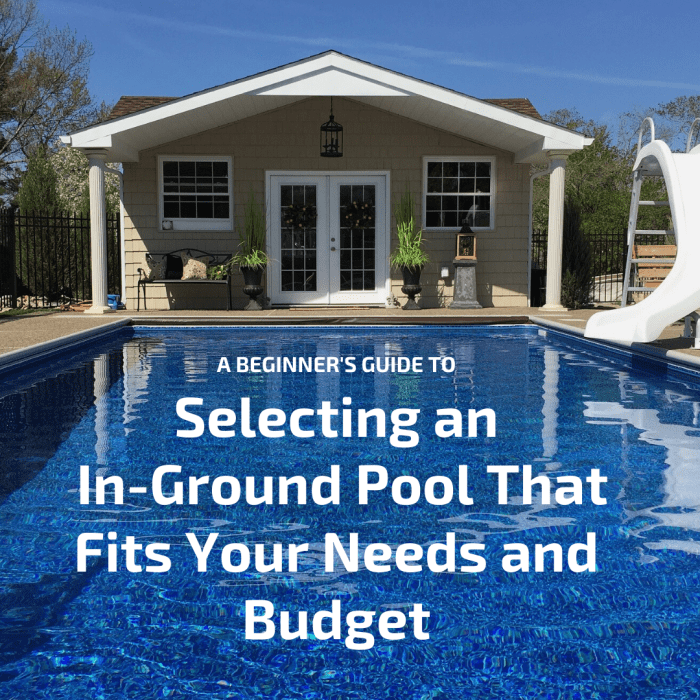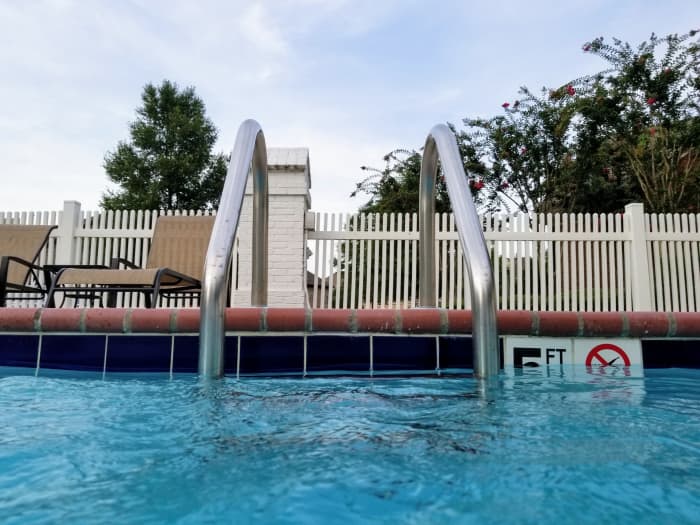Cannot Feed Value of Shape 0
I mostly write articles about in-ground swimming pools, which I've learned about through many months of research.

Thinking of installing an in-ground pool? Well, the first thing you need to do is determine what shape and size you are looking for and what your budget is.
Image by somara from Pixabay
The Most Common Swimming Pool Dimensions
When you're building a new swimming pool, you have to start somewhere. Pools obviously come in many shapes and sizes, and in reality, your options are only limited by the size of your yard and your budget. As a starting point, it's helpful to look at some standard in-ground pool shapes and sizes. From there, you can decide whether to go with a tried-and-true option or deviate from the norm.
What Is a Standard Size Pool?
For rectangular and similarly shaped pools (like kidney-shaped pools, for instance), the typical length-to-width ratio is 2-to-1. Given the size of a typical backyard, that translates to sizes like:
- 16' x 32'
- 15' x 36'
- 20' x 40'
Square, round, and other compact shapes tend to be smaller, with wall lengths (or diameters) typically equal to the widths above.
Depth Options
Depth is the one dimension that isn't limited by the real estate you have to work with, so there's a lot of flexibility here. A lot depends on how the pool is going to be used. However, the prototypical rectangular family pool is something like 3 feet deep on the shallow end and 6 feet at the deep end. If the pool will mainly be used for exercise or swimming laps, it should have a uniform depth of 4 or 5 feet.
Square and round pools usually have a uniform depth, often on the deeper end of the spectrum. Square "plunge pools" are increasingly popular residential pools that are compact but deep enough to live up to their name.

An important thing to think about when installing an in-ground pool is how deep you want it.
Photo by Third Serving on Unsplash
Shapes
- Rectangle: This is by far the most common shape and seems best for facilitating different water depths. It also fits efficiently and attractively in most yards. Many other pool shapes are simply variations of the rectangular shape.
- Square and round pools: These are alternatives for people who don't have a lot of space or don't want to devote a lot of it to a pool.
- Oval: Pools that are oval-shaped fit in the general category of rectangular pools (which often have rounded edges for a softer look).
- Kidney: This is similar to an oval pool but with a slight bend; the crook creates a nice space for landscaping, a patio, or a hot tub/spa.
- L-Shaped: This is a rectangular pool with a second, shorter length. The shorter length is often the shallow play area, whereas the longer length is ideal for lap swimming.
- Lap pool: This is a long and narrow rectangular pool designed for lap swimming
- Freeform: This is not really a shape but a style resembling a natural body of water with lots of curves.
There are many other shapes you can get for an in-ground pool. In fact, if you're building a concrete pool, you can have it shaped however you like.
However, the above are the most common shapes—the ones used not only for prefabricated pools like fiberglass shells and pool kits but also for the vast majority of custom designs.
Choosing the Right Shape and Size for You
Deciding on a pool design is largely a matter of personal preference, but there are a few limitations and guidelines to keep in mind. Here are some questions to ask yourself before you begin.
How Much Space Do I Have? What's My Budget?
If your backyard is small, then a smaller pool with a compact shape may be the best choice. You will also need to figure out how much you're willing to spend. This will determine the size and materials.
Scroll to Continue
Read More From Dengarden
You'll also want to think about how big of a patio or deck you'll want. Most people end up spending more time sitting around the pool than swimming in it, so this is an important thing to factor in.
Who Will Be Using the Pool and for What Reason(s)?
Think about who will be using the pool and how they'll be using it.
- If the pool is primarily for exercise, then you generally want a long and relatively deep pool to make laps easier.
- If it's more for the kids, then a small and shallow pool will do.
- If it's all about luxury, then you might want a rounded or freeform pool with strong aesthetic appeal.
- Do you want a diving board or slide? If so, be sure to make it deep enough. You'll want to check local laws and your homeowner's insurance policy to ensure you are following the rules. This is very important—you don't want anyone to get injured or killed.
- How many people will be using it? If you have a large family or if your house will become the place all of the neighborhood kids will flock to, you may want to think about getting a larger pool. Having a pool makes you suddenly very popular with neighbors and friends!
How Close Will the Pool Be to the House?
Speaking of aesthetics, the position of the pool relative to your house is a factor to consider.
- If the pool is close to the house, you might want to go with the sharper angles of a rectangular or square pool in order to match the man-made contours of your home.
- If the pool is more of a standalone feature, curved corners and/or freeform shapes make it look more natural and blend into the scenery.
Ultimately, the choice is up to you. Knowing some of the basic principles and popular designs is just a launching point for coming up with a plan that suits you and your home.
Material Options
There are three different materials you can use for your in-ground pool: vinyl liner, fiberglass, and concrete. Here are the differences between each of them.
Vinyl Liner
- Weekly care: 2–3 hours
- Renovation: Replace liners after 7–9 years
- 10-year maintenance costs (estimated): $11,000
Fiberglass
- Weekly care: 4–8 hours
- Renovation: Re-surface every 4–7 years
- 10-year maintenance costs (estimated): $16,000
Concrete
- Weekly care: One hour
- Renovation: None
- 10-year maintenance costs (estimated): $4,500
The table below compares the installation costs for each of these materials. As you can see, concrete pools have the highest start-up costs but don't cost as much to maintain.
In-Ground Pool Options Based on Your Budget
| $20k and Under | Under $25k | Under $40k | Under $50k | $50k–100k |
|---|---|---|---|---|
| Build your own vinyl-liner pool (need experience doing this) | Vinyl-liner pool with no features and very little to no decking | Decent vinyl-liner pool | Nice vinyl-lined pool | Concrete pool with landscaping features |
| Install your own fiber-glass pool (costs can accrue quickly though) | Small "cocktail" pool for socializing and lounging | Small fiberglass or concrete pool (you'd have to find a good deal or sacrifice size to stay within budget) | Concrete pool (size may still be limited) | Fiberglass pool with landscaping features |
| Small above-ground pool | – | – | Fiberglass pool (size may still be limited) | Some custom-build pools are in this price-range too. |
Safety Features to Think About
- Fencing: While fences or gates around the pool may technically be optional, it is something you should consider as a safety feature, especially if you have kids or there are kids in the neighborhood. Make sure to check into local laws or homeowner's association (HOA) rules, if applicable.
- Pool cover: Many pool owners have an automatic pool cover so they aren't having to manually cover and uncover the top.
- Underwater pool lights: These are especially important if you'll be swimming at night.
- Pool alarm: This can alert you if someone enters the pool area or falls in.
Building an in-ground pool requires permits and multiple inspections throughout the process. Inquire about these things when selecting a contractor. You want to make sure you're following the rules.
Is an Above-Ground Pool Cheaper?
Yes, definitely. This may be a good option for people who live in places where swimming weather is only around for a few months or those who don't want to spend a pretty penny. While an in-ground pool will add value to your property, an above-ground is easier and cheaper to set up.
Further Reading and Resources
- Closing an In-Ground Swimming Pool? How to Winterize a Pool for an Easy Spring Opening.
This article walks you through the steps of closing an in-ground swimming pool. - Great Plant Choices for Your Poolside Landscape
Learn what to consider when designing a plant bed near your swimming pool. This can create a lush, luxurious environment for lounging and enjoying your poolside retreat for seasons to come!
This article is accurate and true to the best of the author's knowledge. Content is for informational or entertainment purposes only and does not substitute for personal counsel or professional advice in business, financial, legal, or technical matters.
Nancy McClintock from Southeast USA on January 15, 2013:
I would love one!!!
Source: https://dengarden.com/swimming-pools/standard-inground-pool-sizes
0 Response to "Cannot Feed Value of Shape 0"
Post a Comment